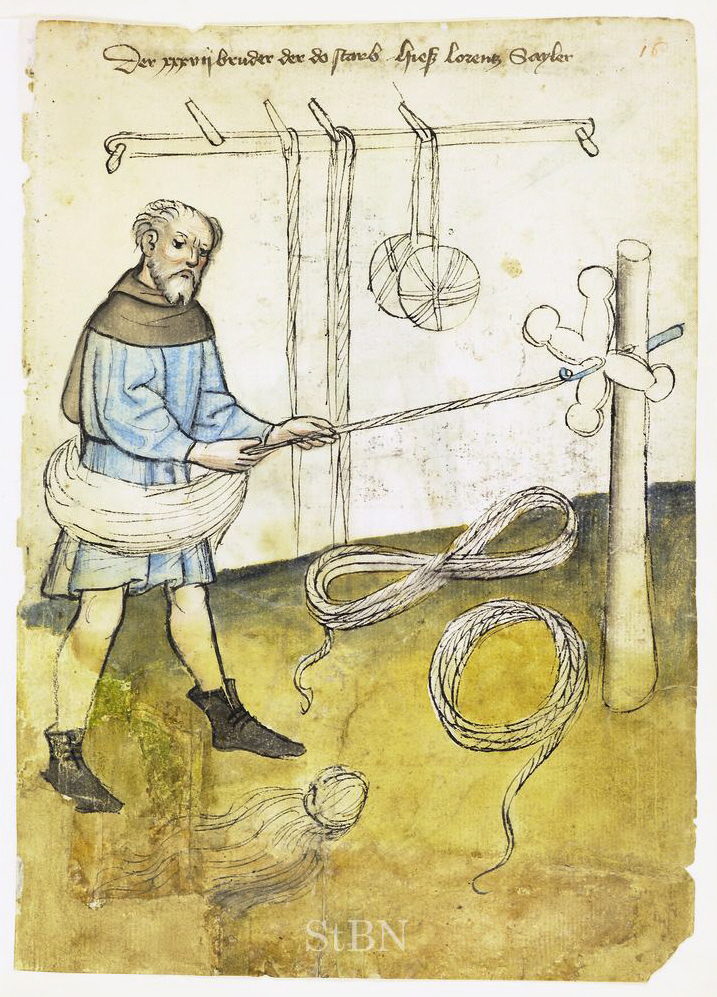Ropemaker
Cliquez ici pour la version française
Le Cordier | The Ropemaker
"Lorentz (Lorenz, Laurentius) Sayler (Sailer; Seiler) , Sayler (Seiler)" (circa 1425 drawing by an unknown artist, Wikimedia Commons)
The cordier, or ropemaker, was a person who knew how to make ropes from different textiles. Hemp was the material most often used, as it was solid and durable. The ropemaker would spin the hemp by twisting its fibres together.
First, the hemp was macerated in water, then skinned to get rid it of its woody parts. To shape the thread, a spinner would attach large handfuls of fibres to his waist, fixing the end of these fibres on a rotating hook and walking backwards, letting the fibres spin. The thread obtained was then reinforced by twisting it; it was combed, and finally, doubled by folding it in half.
To twist this rope and make it into a cable, the ropemaker would use a spinning wheel comprising two easels, each with a crank. One moved three hooks which rotated on themselves, while the other had only one hook of the same type. The distance between the two easels determined the length of the rope that would be produced. When the threads that were to be twisted together were in place (there were normally three), a person located behind each of the two sections of the spinning wheel turned the crank in the same direction. At the same time, a third person adjusted the “toupin”, a kind of wooden grooved spinning top, used to hold the three ropes and serving as a catch inserted between the threads to ensure that the rope would be twisted evenly and that it would not untwist. One of the easels being on wheels, it slowly approached the other as the rope twisted. As the two persons operated the cranks at the same time, each of the three wires twisted on itself, and the three twisted together.
As mentioned, hemp was the primary material used, with linen sometimes used as well. Right from the early days of New France, the colonists realized that both plants grew easily on Canadian soil, providing abundant resources for ropemaking and other uses.
Most of the ropes that were made were destined for ships. By extension, the ropemaker was also skilled at placing, rolling, unrolling, and heaving the ropes of ships. Their occupation was most often exercised in the summer season, while winter was a time for more meticulous work that could be done indoors.
By the 19th century, large hemp rope was replaced by Manila rope, then by chain and steel cables.
The occupation of cordier is the root of the occupational surname Cordeau that survives in Canada today.
Known persons who had this occupation: Alexis Aleaume, Jacques Bigeon, André Cedras, Jean Davenne, Charles Durand dit Lajeunesse, Roger Fury, René George(s), André Leroux, Jacques Lochet, François Pasquier, Pierre Raymond, Evan Rees, Antoine Tranchant
Sources:
Claude Lemay, "Fonctions et métiers délaissés", l'Ancêtre, number 281, volume 34, winter 2008, and number 280, volume 34, winter 2007; electronic edition, Société généalogique de Québec (www.sgq.qc.ca/images/_SGQ/R_LAncetre_plus_libre/ENT-FONCTIONS-METIERS-DELAISSES.pdf).
Jeanne Pomerleau, Arts et métiers de nos ancêtres : 1650-1950 (Montréal, Québec: Guérin, 1994), 167-171.
